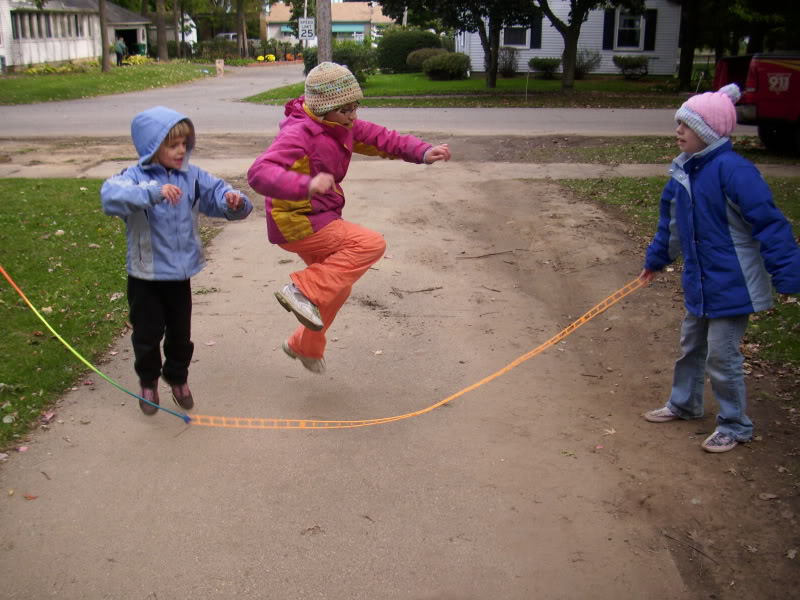
-
МјРЇСІИёСЖШИМі
-
 MINUTE TO WIN IT
MINUTE TO WIN IT 46,695
46,695 -
 Apple Eating Contest Game
Apple Eating Contest Game 34,161
34,161 -
 SINGING BEE
SINGING BEE 23,646
23,646 -
 DEAL OR NO DEAL23,224
DEAL OR NO DEAL23,224 -
 rodeo masbatenio19,385
rodeo masbatenio19,385 -
 Luksong Lubid14,172
Luksong Lubid14,172 -
 Tumbang Preso12,113
Tumbang Preso12,113 -
 HULA HOOP12,085
HULA HOOP12,085 -
 EGG AND SPOON RACE12,078
EGG AND SPOON RACE12,078 -
 BUNONG BRASO ( ARM WRESTLING)12,006
BUNONG BRASO ( ARM WRESTLING)12,006
SKIPPING ROPE
Jump rope (American English) or skipping rope (British English)
is the primary tool used in the game of skipping played by
children and many young adults, where one or more
participants jump over a rope swung so that it passes under
their feet and over their heads. This may consist of one
participant turning and jumping the rope, or a minimum of three
participants taking turns, two of whom turn the rope while one
or more jumps. This is called long rope. Sometimes the latter is
played with two turning ropes; this form of the activity is
called Double Dutch and is more difficult. Jump-rope rhymes
are often chanted beginning when the skipper jumps in and
ending when the skipper messes up.
Jumping rope techniques
In competitive jump rope, competitors are required to have
three elements in their routine[citation needed]: Multiple unders
(when the rope passes under the feet multiple times in
the air), strength or inversion/displacement, which consists
of tricks utilizing a jumper's strength such as the frog/donkey
kick, and rope manipulations, when one or both of the handles
are released and caught, when jumpers cross the rope over
their body, or when they wrap it around one of their limbs.
Crosses, side swings, EB jumps, toads, and inverse toads
are all examples of rope manipulations.

- ЁЄ
- ЁЄ
- ЁЄSalapan Festival
- ЁЄEmpanada Festival (Batac City)
- ЁЄPADUL-ONG FESTIVAL
- ЁЄKaumahan Festival in Barili
- ЁЄKAGASANGAN FESTIVAL
- ЁЄLalin Festival in Asturias
- ЁЄTinabuay Festival
- ЁЄGayon Bicol Festival
- ЁЄPINYASAN FESTIVAL in CAMARINES
- ЁЄMAGAYON FESTIVAL
- ЁЄBANAUAN FESTIVAL (BARANGAY.GUA
- ЁЄThe Tuna Festival in Gensan
- ЁЄPINTOS FESTIVAL BOGO CITY, CEB



- ЁЄ
- ЁЄ
- ЁЄ
- ЁЄCEBU WESTOWN LAGOON
- ЁЄGREEN LAGOON, COMPOSTELA
- ЁЄCALLAO CAVE
- ЁЄMOUNT PINATUBO IN PHILIPPINES
- ЁЄBATAN ISLAND in Batanes.
- ЁЄCALAGUAS ISLAND, CAMARINES NOR
- ЁЄAGHO ISLAND
- ЁЄCARAMOAN ISLAND IN CAMARINES S
- ЁЄSAMBAWAN ISLAND
- ЁЄPLACES TO VISIT IN LANAO DEL N
- ЁЄPLACES TO VISIT IN ZAMBOANGA C
- ЁЄPlaces to visit in Rizal Provi













 ЧЪРкДхФФ ОпАЃЛѓДу ПРЧТ
ЧЪРкДхФФ ОпАЃЛѓДу ПРЧТ 12ГтПЌМг МвКёРкИИСЗ 1РЇ
12ГтПЌМг МвКёРкИИСЗ 1РЇ
 ГЛАд ИТДТ ОюЧаПј УЃБт
ГЛАд ИТДТ ОюЧаПј УЃБт
 ИЎОѓ ЧаБГ ЙцЙЎБт
ИЎОѓ ЧаБГ ЙцЙЎБт
 СжИЛПЁ ГЛАЁ ОЕ КёПыРК?
СжИЛПЁ ГЛАЁ ОЕ КёПыРК? УжАэАЁМККё РЬКЅЦЎ СёБтБт
УжАэАЁМККё РЬКЅЦЎ СёБтБт
 ЧіСіПЁМЕЕ ЧЪРкДхФФ!
ЧіСіПЁМЕЕ ЧЪРкДхФФ! ЧіСіПЁМ АЁДЩЧб
ЧіСіПЁМ АЁДЩЧб









 ЧЪРк ЦЏБо Ч§ХУ! ФСНУОюСі МКёНК
ЧЪРк ЦЏБо Ч§ХУ! ФСНУОюСі МКёНК












































